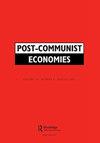Convergence patterns in income and manufacturing productivity in EU: does the latter drive the former?
IF 1.8
3区 经济学
Q2 ECONOMICS
引用次数: 0
Abstract
ABSTRACT While exploring convergence in real income and in manufacturing productivity of the central and eastern European countries (CEE) and the southern EU counties with the developed EU ones, testing and clustering methodology and sigma convergence are used. We found that CEE countries strongly converge, both in real income and manufacturing productivity, with developed EU countries, while the southern EU countries do not. Moreover, the convergence pattern in real income follows that in manufacturing productivity in both peripheral EU groups suggesting that the underlying productivity clubs determine the formation of income clubs. The observed time pattern of sigma convergence also suggests that manufacturing productivity drives economic growth, as (non)convergence of the former preceded (‘caused’) that of the latter. Aforementioned findings are robust, since they are supported by the results obtained both by the Phillips and Sul (2007) approach and sigma convergence.欧盟收入和制造业生产率的趋同模式:后者是否推动前者?
在探讨中东欧国家和欧盟南部国家与欧盟发达国家在实际收入和制造业生产率方面的收敛性时,采用了检验和聚类方法以及sigma收敛方法。我们发现,中东欧国家在实际收入和制造业生产率方面与欧盟发达国家高度趋同,而欧盟南部国家则不然。此外,实际收入的趋同模式遵循了两个欧盟外围国家制造业生产率的趋同模式,这表明潜在的生产率俱乐部决定了收入俱乐部的形成。观察到的西格玛收敛的时间模式也表明,制造业生产率推动经济增长,因为前者的(非)收敛先于后者(“导致”)收敛。上述发现是稳健的,因为它们得到了Phillips和Sul(2007)方法和sigma收敛所获得的结果的支持。
本文章由计算机程序翻译,如有差异,请以英文原文为准。
求助全文
约1分钟内获得全文
求助全文
来源期刊

Post-Communist Economies
ECONOMICS-
CiteScore
4.90
自引率
18.20%
发文量
21
期刊介绍:
Post-Communist Economies publishes key research and policy articles in the analysis of post-communist economies. The basic transformation in the past two decades through stabilisation, liberalisation and privatisation has been completed in virtually all of the former communist countries, but despite the dramatic changes that have taken place, the post-communist economies still form a clearly identifiable group, distinguished by the impact of the years of communist rule. Post-communist economies still present distinctive problems that make them a particular focus of research.
 求助内容:
求助内容: 应助结果提醒方式:
应助结果提醒方式:


